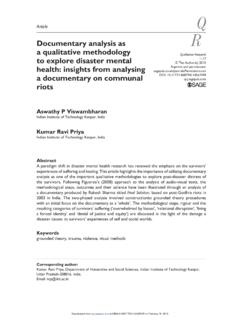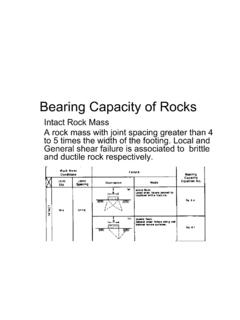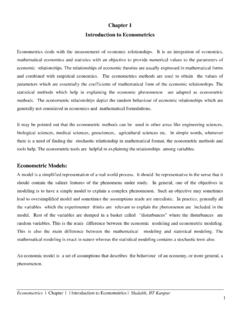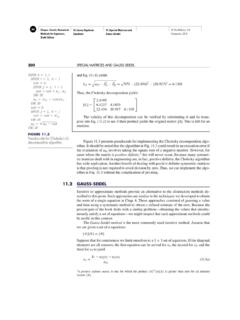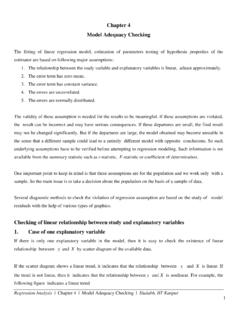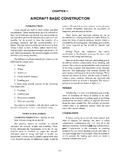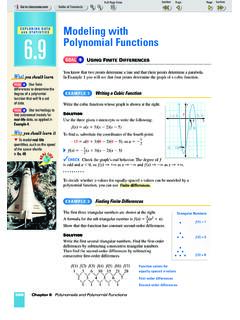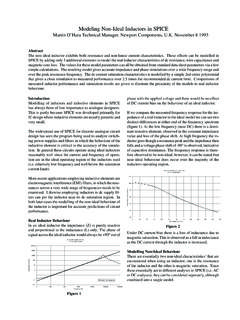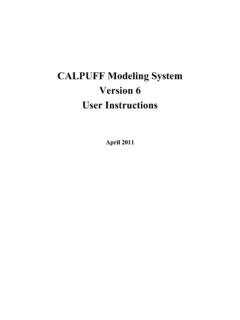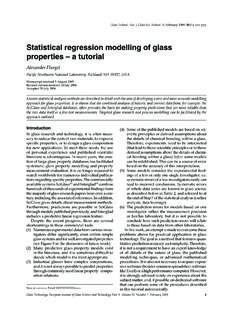Transcription of Chapter 12 Polynomial Regression Models - IIT …
1 Regression Analysis | Chapter 12 | Polynomial Regression Models | Shalabh, IIT Kanpur 1 1 1 Chapter 12 Polynomial Regression Models A model is said to be linear when it is linear in parameters. So the model 201 2yxx =++ + and 2201 12 211 122 212 1 2yxxxxxx =++ + + + + are also the linear model . In fact, they are the second order polynomials in one and two variables respectively. The Polynomial Models can be used in those situations where the relationship between study and explanatory variables is curvilinear.
2 Sometimes a nonlinear relationship in a small range of explanatory variable can also be modeled by polynomials . Polynomial Models in one variable The thk order Polynomial model in one variable is given by 201 = + + ++ + If ,1, 2,.., ,jjx xjk== then the model is multiple linear regressions model in k explanatory variables 12, ,.., .kxxx So the linear Regression model yX = + includes the Polynomial Regression model . Thus the techniques for fitting linear Regression model can be used for fitting the Polynomial Regression model .
3 For example: 201 2yxx =++ + or 201 2()Eyxx =++ is a Polynomial Regression model in one variable and is called as second order model or quadratic model . The coefficients 1 and 2 are called the linear effect parameter and quadratic effect parameter respectively. Regression Analysis | Chapter 12 | Polynomial Regression Models | Shalabh, IIT Kanpur 2 2 2 The interpretation of parameter 0 is 0()Ey = when 0x= and it can be included in the model provided the range of data includes If 0x= is not included, then 0 has no interpretation.
4 An example of quadratic model is like as follows: The Polynomial Models can be used to approximate a complex nonlinear relationship. The Polynomial Models is just the Taylor series expansion of the unknown nonlinear function in such a case. Considerations in fitting Polynomial in one variable Some of the considerations in fitting Polynomial model are as follows: 1. Order of the model The order of the Polynomial model is kept as low as possible. Some transformations can be used to keep the model to be of first order. If this is not satisfactory, then second order Polynomial is tried.
5 Arbitrary fitting of higher order polynomials can be a serious abuse of Regression analysis. A model which is consistent with the knowledge of data and its environment should be taken into account. It is always possible for a Polynomial of order (1)n to pass through n points so that a Polynomial of sufficiently high degree can always be found that provides a good fit to the data. Such Models neither enhance the understanding of the unknown function nor be a good predictor. Regression Analysis | Chapter 12 | Polynomial Regression Models | Shalabh, IIT Kanpur 3 3 3 2.
6 model building strategy: A good strategy should be used to choose the order of an approximate Polynomial . One possible approach is to successively fit the Models in increasing order and test the significance of Regression coefficients at each step of model fitting. Keep the order increasing until t-test for the highest order term is nonsignificant. This is called as forward selection procedure. Another approach is to fit the appropriate highest order model and then delete terms one at a time starting with highest order.
7 This is continued until the highest order remaining term has a significant t-statistic. This is called as backward elimination procedure. The forward selection and backward elimination procedures does not necessarily lead to same model . The first and second order polynomials are mostly used in practice. 3. Extrapolation: One has to be very cautions in extrapolation with Polynomial Models . The curvatures in the region of data and region of extrapolation can be different. For example, in the following figure, the trend of data in the region of original data is increasing but it is decreasing in the region of extrapolation.
8 So predicted response will not be based on the true behaviour of the data. In general, Polynomial Models may have unanticipated turns in inappropriate directions. This may provide incorrect inferences in interpolation as well as extrapolation. Regression Analysis | Chapter 12 | Polynomial Regression Models | Shalabh, IIT Kanpur 4 4 4 4. Ill-conditioning: A basic assumption in linear Regression analysis is that rank of X-matrix is full column rank. In Polynomial Regression Models , as the order increases, the 'XXmatrix becomes ill-conditioned.
9 As a result, the 1(')XX may not be accurate and parameters will be estimated with considerable error. If values of x lie in a narrow range then the degree of ill-conditioning increases and multicollinearity in the columns of X matrix enters. For example, if x varies between 2 and 3 , then2x varies between 4 and 9. This introduces strong multicollinearity between x and 2x. 5. Hierarchy: A model is said to be hierarchical if it contains the terms 23,,xx x, etc. in a hierarchy. For example, the model 23401 234yxxxx =+++++ is hierarchical as it contains all the terms upto order four.
10 The model 2401 24yxx x =++++ is not hierarchical as it does not contain the term of 3x. It is expected that all Polynomial Models should have this property because only hierarchical Models are invariant under linear transformation. This requirement is more attractive from mathematics point of view. In many situations, the need of model may be different . For example, the model 01 112 1 2yxxx =++ + needs a two factor interaction which is provided by the cross-product term. A hierarchical model would need inclusion of 2x which is not needed from the point of view of statistical significance perspective.
